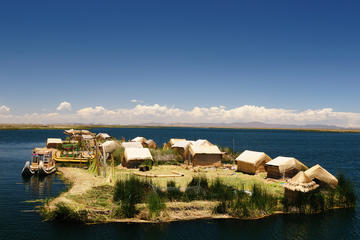
Uros Islands/Islas Uros
The 40-plus floating Uros Islands are perhaps the most photographed attraction on Lake Titicaca, famously constructed with springy totora reeds. The reeds are collected from around the shores of Lake Titicaca, and used to replenish the fragile islands every three months or so, as the bottom of the two-meter (6.5ft) totora mat slowly rots back into the lake. Thus, the islands change shape, size and even number as the centuries pass, anchored to the lake bottom but in many ways a completely separate world.
The Uros people are an ancient race, predating the Incas by millennia and, according to local legend, even the sun and stars. The “People of the Lake,” as they call themselves, once said that they did not feel the cold, thanks to their “black blood.” (The last full-blooded Uros woman died in 1959, after centuries of intermarriage with Aymaras and other races, so that claim is subject to some conjecture.)
Heavily taxed by the Incas and enslaved in the silver mines by the Spanish, the Uros have managed, through ingenuity and isolation, to outlast their tormentors with their unique culture largely in place. The key to their survival is the reeds, whose starchy tubers are consumed for food, flowers brewed to make tea, and stalks used for medicine, handicrafts, and the construction of gondolas, homes, schools, churches and just about everything else on the islands.
The islands change in size and number over the centuries and will quickly thin if not meticulously maintained. Tourism on the handful accessible to tourists is relatively open and you can arrange trips with several Puno travel agencies or even come on your own, in public boats that leave regularly from the Puno pier. The 5km (3mi) trip takes about thirty minutes.
The islands are part of Titicaca National Reserve which protects 37,000 hectares (143 square miles) of reed bed, including some 60 species of bird and 14 of fish, many collected by the Uros for meat, eggs, and as work animals, such as cormorants used to fish. You’ll also see plenty of domesticated cats, to keep mice from devouring the delicate islands.
While many of the Uros traditions have been maintained, the islands are by no means frozen in time. For example, they no longer speak their original language, having switched to Aymara after centuries of trade and intermarriage, and have more recently embraced technology, such as electrical generators, modern motors on reed boats and so forth.
Tourism has brought money and opportunity to the islands, which cuts into time once spent doing traditional activities, such as the all-important collection of totora. They are savvy enough to know their time’s worth, so expect to be charged for photos and/or offered handicrafts with a cheerfully hard sell.
